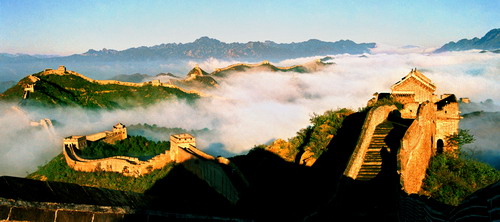A province rich in history and culture, today’s Hebei was home to ancient humans as far back as 1 million years ago. More than 80 ancient relics from the Paleolithic to the Neolithic eras have been unearthed in Hebei’s Nihewan village of Yangyuan county, whose density and early dates rival the universally recognized site of human origin – Olduvai Gorge in Africa.
Imperial Summer Villa
The economy and culture of Hebei were among the most developed in ancient China. Today the province has many historic sites that make it an important tourist destination. Kangxi, the influential emperor in Qing Dynasty (1644-1911), called his summer creation Bishu Shanzhuang — Fleeing the Heat Mountain Villa — now known as the Imperial Summer Villa.
In the north of Chengde about 200 km from Beijing, now called Imperial Mountain Resort, the summer residence of Qing emperors for nearly 300 years has exquisite towers, pavilions and terraces, hills and lakes within the palace that contrast sublimely with each other.
Through rich and varied ancient architecture, the villa displays the roughness of northerners and the more delicate southerners. Outside the walls, eight outer temples, built in styles of different nationalities, created an atmosphere of political harmony and unity.
China’s largest imperial burial grounds are also in Hebei — the mausoleums of Qing Dynasty, with the eastern tombs in Zunhua county and the western tombs in Yixian county. They are listed along with the Imperial Summer Villa and Shanhaiguan, the beginning of the Great Wall, as UNESCO World Heritage sites.
Other tourism sites
Other historical wonders include the Cangzhou Lion, named Zhen Haihou, cast in the Late Zhou Dynasty of the Five Dynasties period (AD907-960), more than six m in length and weighing 40 tons. Dingzhou Tower, also called Kaiyuan Temple, built in the Song Dynasty (960-1279), is at 81.7-m tall the highest brick tower of ancient China. Zhaozhou Bridge built of stone by famous craftsman Li Chun of the Sui Dynasty (581-618) has survived several large earthquakes due to its sophisticated construction technique. Longxing Monastery, home to the Zhengding Buddha, is the oldest existing monastery in China.

The Ming Dynasty (1368-1644) Great Wall crosses northern Hebei. Its eastern end is located on the province’s coast at Shanhaiguan, informally known as the “first pass in the world”, which also marks the entrance to Manchuria or northeast China. For centuries Manchuria was known as “outside the pass” or “east of the pass”.
Beidaihe, located near Shanhaiguan, is a popular beach resort well known as a former summer meeting place for top governmental officials.
Zhili Governor’s Office
In 1928 Hebei was formed after the central government dissolved the province of Zhili, which meant “directly ruled” by the Imperial Court. In the center of Baoding, the Zhili Provincial Governor’s Office is a mirror on part of history of the Qing Dynasty.
Many important figures in modern Chinese history passed through the office. One was Zeng Guofan, a prominent figure in late Qing Dynasty, who raised the Xiang Army to fight the Taiping Rebellion and restored stability of Qing Dynasty. Another noted governor was Li Hongzhang, who became Zeng’s successor in 1870, who was followed by Rong Lu and Yuan Shikai. All were pivotal figures who highlighted the prominence of Zhili province in the history of the Qing Dynasty.
Encompassing the centrally administrated municipalities of Beijing and Tianjin, Hebei is a geographically important province. Since its days as one of the most developed regions in ancient China, it has built a sound foundation for further development relying on the advantages of culture, administration, logistics, transportation, communications, science and technology, and the big cities it surrounds.
Today, the Hebei government has a “two-loop” strategy for making full use of its location adjacent to Beijing, Tianjin and the Bohai Bay to enhance cooperation on production, scientific research, education, tourism and other areas as well as promote its own economic and social development.
Special local products
Vegetables: Cangzhou preserved vegetables, Qizhou radix rhapontici, high quality rice in Zhuozhou and Weizhou
Fruit: Jinzhou pear, Shenzhou peach, Xuanhua white grape, Cangzhou jujube
Wine: Hengshui Laobaigan liquor, Handan Congtai liquor, Xushui Liuling liquor
Livestock: Zhangbei horse, Dingzhou pig, Wu’an goat, Bashang long-tail chicken
Craft: Weixian paper cuts, Houdian writing brush, Wuqiang New Year picture, Tangshan pottery, Quyang stone carving, Gu’an wicker products, Biyan pots. |